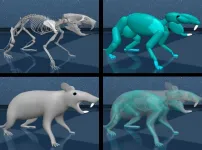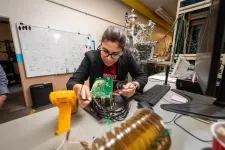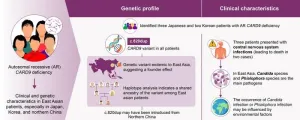(Press-News.org) The agility with which humans and animals move is an evolutionary marvel that no robot has yet been able to closely emulate. To help probe the mystery of how brains control movement, Harvard neuroscientists have created a virtual rat with an artificial brain that can move around just like a real rodent.
Bence Ölveczky, professor in the Department of Organismic and Evolutionary Biology, led a group of researchers who collaborated with scientists at Google’s DeepMind AI lab to build a biomechanically realistic digital model of a rat. Using high-resolution data recorded from real rats, they trained an artificial neural network – the virtual rat’s “brain” – to control the virtual body in a physics simulator called MuJoco, where gravity and other forces are present.
Publishing in Nature, the researchers found that activations in the virtual control network accurately predicted neural activity measured from the brains of real rats producing the same behaviors, said Ölveczky, who is an expert at training (real) rats to learn complex behaviors in order to study their neural circuitry. The feat represents a new approach to studying how the brain controls movement, Ölveczky said, by leveraging advances in deep reinforcement learning and AI, as well as 3D movement-tracking in freely behaving animals.
The collaboration was “fantastic,” Ölveczky said. “DeepMind had developed a pipeline to train biomechanical agents to move around complex environments. We simply didn’t have the resources to run simulations like those, to train these networks.”
Working with the Harvard researchers was, likewise, “a really exciting opportunity for us,” said co-author and Google DeepMind Senior Director of Research Matthew Botvinick. “We’ve learned a huge amount from the challenge of building embodied agents: AI systems that not only have to think intelligently, but also have to translate that thinking into physical action in a complex environment. It seemed plausible that taking this same approach in a neuroscience context might be useful for providing insights in both behavior and brain function.”
Graduate student Diego Aldarondo worked closely with DeepMind researchers to train the artificial neural network to implement what are called inverse dynamics models, which scientists believe our brains use to guide movement. When we reach for a cup of coffee, for example, our brain quickly calculates the trajectory our arm should follow and translates this into motor commands. Similarly, based on data from actual rats, the network was fed a reference trajectory of the desired movement and learned to produce the forces to generate it. This allowed the virtual rat to imitate a diverse range of behaviors, even ones it hadn’t been explicitly trained on.
These simulations may launch an untapped area of virtual neuroscience in which AI-simulated animals, trained to behave like real ones, provide convenient and fully transparent models for studying neural circuits, and even how such circuits are compromised in disease. While Ölveczky’s lab is interested in fundamental questions about how the brain works, the platform could be used, as one example, to engineer better robotic control systems.
A next step might be to give the virtual animal autonomy to solve tasks akin to those encountered by real rats. “From our experiments, we have a lot of ideas about how such tasks are solved, and how the learning algorithms that underlie the acquisition of skilled behaviors are implemented,” Ölveczky continued. “We want to start using the virtual rats to test these ideas and help advance our understanding of how real brains generate complex behavior.”
END
Harvard, Google DeepMind researchers create realistic virtual rodent
Neural network could reveal how brains control complex, coordinated movement
2024-06-11
ELSE PRESS RELEASES FROM THIS DATE:
Scientists unlock secrets of how the third form of life makes energy
2024-06-11
Scientists unlock secrets of how the third form of life makes energy.
An international scientific team has redefined our understanding of archaea, a microbial ancestor to humans from two billion years ago, by showing how they use hydrogen gas.
The findings, published today in Cell, explain how these tiny lifeforms make energy by consuming and producing hydrogen. This simple but dependable strategy has allowed them to thrive in some of Earth’s most hostile environments for billions of years.
The paper, led by Monash University Biomedicine Discovery Institute scientists, including ...
Would astronauts’ kidneys survive a roundtrip to Mars?
2024-06-11
The structure and function of the kidneys is altered by space flight, with galactic radiation causing permanent damage that would jeopardise any mission to Mars, according to a new study led by researchers from UCL.
The study, published in Nature Communications, is the largest analysis of kidney health in space flight to date and includes the first health dataset for commercial astronauts. It is published as part of a Nature special collection of papers on space and health.
Researchers have known that space flight causes certain health issues since the 1970s, in the ...
Depressive symptoms may hasten memory decline in older people
2024-06-11
Depressive symptoms are linked to subsequent memory decline in older people, while poorer memory is also linked to an increase in depressive symptoms later on, according to a new study led by researchers at UCL and Brighton and Sussex Medical School.
The study, published in JAMA Network Open, looked at 16 years of longitudinal data from 8,268 adults in England with an average age of 64.
The researchers concluded that depression and memory were closely interrelated, with both seeming to affect each other.
Senior author Dr Dorina Cadar, of the UCL Department of Behavioural Science & Health and Brighton and Sussex Medical School, said: “It is ...
New technique could help build quantum computers of the future
2024-06-11
Quantum computers have the potential to solve complex problems in human health, drug discovery, and artificial intelligence millions of times faster than some of the world’s fastest supercomputers. A network of quantum computers could advance these discoveries even faster. But before that can happen, the computer industry will need a reliable way to string together billions of qubits – or quantum bits – with atomic precision.
Connecting qubits, however, has been challenging for the research community. Some methods form qubits by placing ...
Trash-sorting robot mimics complex human sense of touch
2024-06-11
WASHINGTON, June 11, 2024 – Today’s intelligent robots can accurately recognize many objects through vision and touch. Tactile information, obtained through sensors, along with machine learning algorithms, enables robots to identify objects previously handled.
However, sensing is often confused when presented with objects similar in size and shape, or objects unknown to the robot. Other factors restrictive to robot perception include background noise and the same type of object with different shapes and sizes.
In Applied Physics Reviews, by AIP Publishing, researchers from Tsinghua University worked to break through the difficulties ...
Shedding light on the origin of a genetic variant underlying fungal infections
2024-06-11
Researchers from Japan uncover the genetic diversity and regional patterns of CARD9 deficiency in patients susceptible to fungal diseases
Tokyo, Japan – Fungal infections pose life-threatening risks, especially when vital organs or the central nervous system are affected. Individuals harboring variants in the CARD9 gene are particularly susceptible to invasive fungal infections, given that the protein coded by this gene serves as a critical regulator of the immune system. A recent discovery ...
Humanitarian organizations showed flexibility and grit during COVID supply chain disruptions: study
2024-06-11
When the COVID-19 pandemic hit, it sent shock waves across global supply chains. But manufacturers and other businesses weren’t the only ones hit hard: local and international aid organizations, tasked with providing humanitarian assistance during times of crisis, suddenly had a major crisis of their own. How would they get the supplies they needed to carry out their crucial work?
According to a new study by the UBC Sauder School of Business, the organizations showed remarkable nimbleness and ingenuity — and while the pandemic was an unusual event, their approaches can provide powerful insights ...
Research on the visual rabbit illusion takes a leap forward
2024-06-11
Fukuoka, Japan—Researchers from Kyushu University have uncovered new variations to a traditional illusion, based on how we perceive the motion of flashing lights. Published on May 21 in i-Perception, the findings show that when three light flashes are presented in rapid succession in our side vision, our brain tends to perceive them in a straight line, with the second flash around the midpoint, no matter the actual location of the second flash. This research, which earned the journal’s Early Career Best Paper Prize this year, offers new perspectives on perceptual errors ...
Virus-like nanoparticles control the multicellular organization and reproduction of host bacteria
2024-06-11
Tsukuba, Japan—Viruses are ubiquitous in the environment, and organisms have developed various mechanisms to counter their threat. However, the genome of actinomycetes contains a highly conserved gene set encoding virus-like nanoparticles, although its biological significance has remained unclear.
In this study, researchers examined Streptomyces davawensis, an actinomycete species, and discovered that it produces virus-like particles that facilitate host reproduction. Extracellular DNA, which serves as a scaffold for multicellular organization, was significantly reduced in the colonies of mutant S. davawensis strains ...
Origins of fast radio bursts come into focus through polarized light
2024-06-11
TORONTO, ON, June 11, 2024 — What scientists previously thought about where Fast Radio Bursts (FRBs) come from is just the tip of the iceberg, according to new research led by astronomers at the University of Toronto. The mysteries of the millisecond-long cosmic explosions are unfolding with a new way of analyzing data from the Canadian Hydrogen Intensity Mapping Experiment (CHIME).
Published today in The Astrophysical Journal, the study details the properties of polarized light from 128 non-repeating FRBs — those from sources that have ...
LAST 30 PRESS RELEASES:
Automatic label checking: The missing step in making reliable medical AI
Low daily alcohol intake linked to 50% heightened mouth cancer risk in India
American Meteorological Society announces Rick Spinrad as 2026 President-Elect
Biomass-based carbon capture spotlighted in newly released global climate webinar recording
Illuminating invisible nano pollutants: advanced bioimaging tracks the full journey of emerging nanoscale contaminants in living systems
How does age affect recovery from spinal cord injury?
Novel AI tool offers prognosis for patients with head and neck cancer
Fathers’ microplastic exposure tied to their children’s metabolic problems
Research validates laboratory model for studying high-grade serous ovarian cancer
SIR 2026 delivers transformative breakthroughs in minimally invasive medicine to improve patient care
Stem Cell Reports most downloaded papers of 2025 highlight the breadth and impact of stem cell research
Oxford-led study estimates NHS spends around 3% of its primary and secondary care budget on the health impacts of heat and cold in England
A researcher’s long quest leads to a smart composite breakthrough
Urban wild bees act as “microbial sensors” of city health.
New study finds where you live affects recovery after a hip fracture
Forecasting the impact of fully automated vehicle adoption on US road traffic injuries
Alcohol-related hospitalizations from 2016 to 2022
Semaglutide and hospitalizations in patients with obesity and established cardiovascular disease
Researchers ‘listen in’ to embryo-mother interactions during implantation using a culture system replicating the womb lining
How changing your diet could help save the world
How to make AI truly scalable and reliable for real-time traffic assignment?
Beyond fragmented markets: A new framework for efficient and stable ride-pooling
Can shape priors make road perception more reliable for autonomous driving?
AI tracks nearly 100 years of aging research, revealing key trends and gaps
Innovative techniques enable Italy’s first imaging of individual trapped atoms
KIER successfully develops Korea-made “calibration thermoelectric module” for measuring thermoelectric device performance
Diversifying US Midwest farming for stability and resilience
Emphasizing immigrants’ deservingness shifts attitudes
Japanese eels, climate change, and river temperature
Pusan National University researchers discover faster, smarter heat treatment for lightweight magnesium metals
[Press-News.org] Harvard, Google DeepMind researchers create realistic virtual rodentNeural network could reveal how brains control complex, coordinated movement







